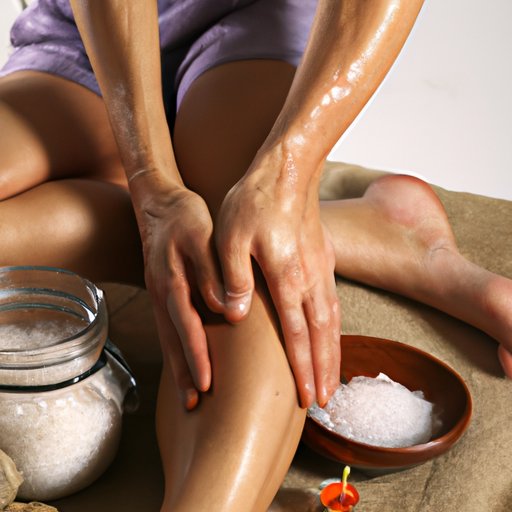Introduction
In this article, we’ll provide actionable tips for immediate relief from leg pain. The recommendations include stretching exercises, the R.I.C.E method, massage therapy, topical pain relievers, home remedies, and tips for avoiding triggers.
Stretching Exercises
Stretching is a crucial component of pain management. It can help increase flexibility, improve circulation, and reduce inflammation. Here are a few stretching exercises you can incorporate:
- Low Lunge: Kneel with one foot in front and the other knee on the ground. Shift your weight forward onto the front leg until you feel a stretch in the back leg’s hip flexors and quadriceps.
- Hamstring Stretch: Sit on the ground with one leg straightened out and the other leg bent with the sole of your foot on the ground. Lean forward until you feel a stretch in your hamstring muscles.
- Glute Stretch: Lie on your back and pull one knee towards your chest. Cross the opposite ankle over the knee and gently pull the knee towards your chest until you feel a stretch in your gluteal muscles.
- Calf Stretch: Stand with your hands on a wall and place one foot behind the other. Lean forward with the back leg straightened until you feel a stretch in your calf muscles.
R.I.C.E Method
The R.I.C.E method is an effective way to reduce pain, swelling, and inflammation. The acronym stands for Rest, Ice, Compression, and Elevation. Here’s how to use this method:
- Rest: Avoid placing weight on the affected leg and take a break from activities that trigger pain.
- Ice: Apply an ice pack to the affected area for 20 minutes at a time, several times a day, to reduce inflammation and numb the affected area.
- Compression: Wrap the affected area with an elastic bandage to reduce swelling and provide support.
- Elevation: Elevate the affected leg above the heart level for 20 minutes at a time to reduce swelling and improve circulation.
Massage Therapy
Massage therapy is an excellent option for relieving leg pain. It helps increase circulation, decrease inflammation, and improve flexibility. Here are a few options:
- Self-massage: Use your hands or a foam roller to knead and roll out knots and tight muscles in the affected leg.
- Professional massage: Schedule an appointment with a licensed massage therapist who has experience in treating leg pain.
Topical Pain Relievers
Over-the-counter topical pain relievers are another option for immediate relief from leg pain. Here are a few recommended products:
- Biofreeze Gel: Apply to the affected area up to four times a day for pain relief.
- Icy Hot Cream: Rub into the affected area for relief from muscle pain, arthritis, or bruises.
- Aspercreme Odor-Free Cream: Apply generously to the affected area and massage until completely absorbed for pain relief.
Home Remedies
Home remedies are a natural way to manage leg pain. Here are a few options:
- Hot and Cold Packs: Alternate hot and cold packs on the affected area to reduce inflammation and improve circulation.
- Epsom Salt Bath: Soak in a warm bath with two cups of Epsom salt for at least 20 minutes to reduce inflammation and promote relaxation.
- Turmeric: Add one teaspoon of turmeric powder to a glass of warm milk or water and drink it twice a day for its anti-inflammatory properties.
Avoiding Triggers
Preventing leg pain from occurring in the first place is an effective way to manage pain. Here are a few tips for avoiding triggers:
- Avoid high-impact activities: Activities like running or jumping can put a strain on your legs and cause pain. Instead, try low-impact exercises like yoga or swimming.
- Improve posture: Poor posture can contribute to leg pain over time. Be mindful of your posture while standing, walking, or sitting.
Conclusion
Leg pain can be a hindrance to your daily activities, but implementing a combination of these treatment options can ease discomfort and prevent further pain. Remember to seek the advice of a medical professional if your pain persists. Stay active, stretch regularly, and maintain healthy habits while protecting your body from painful leg conditions.
